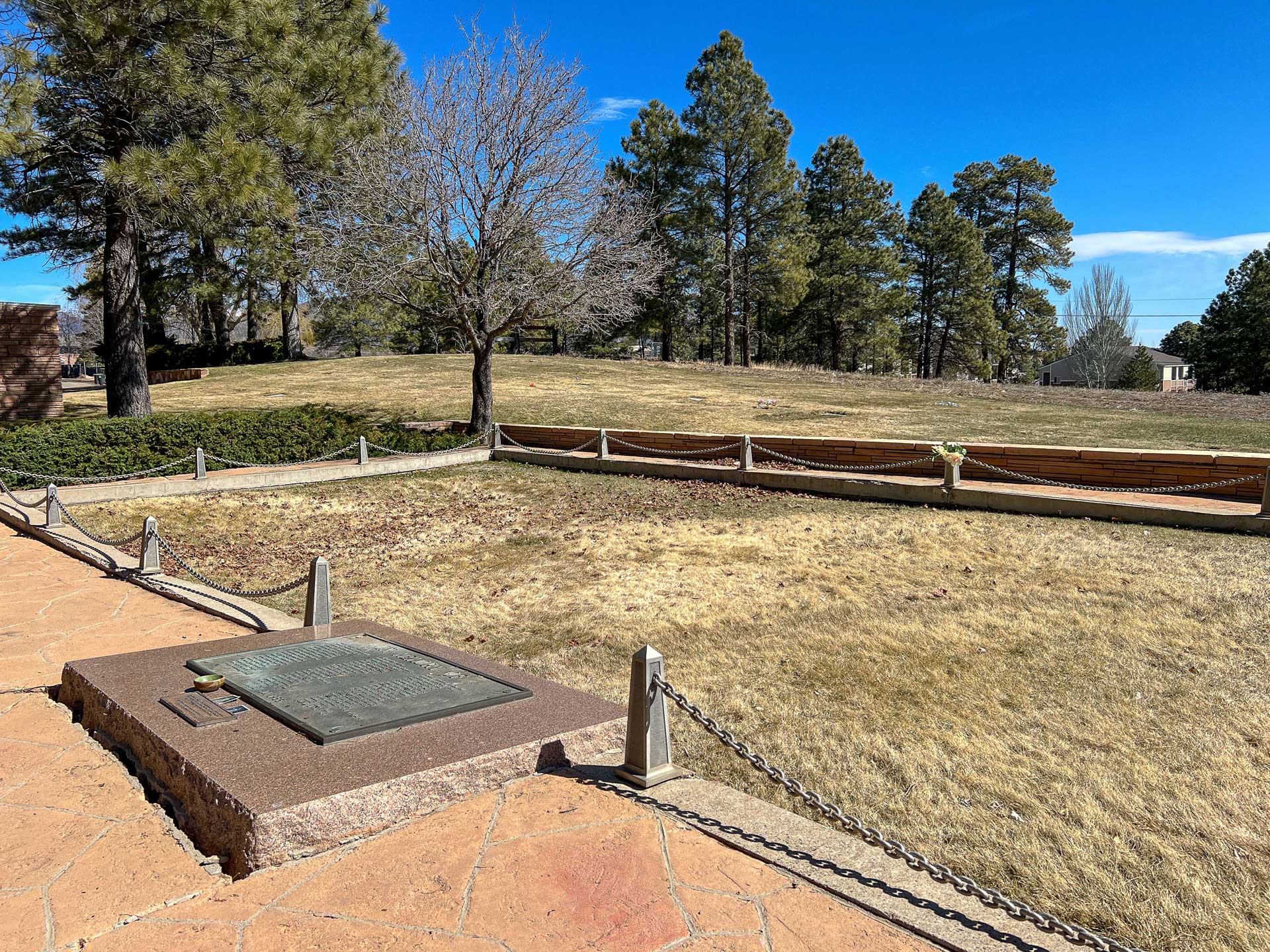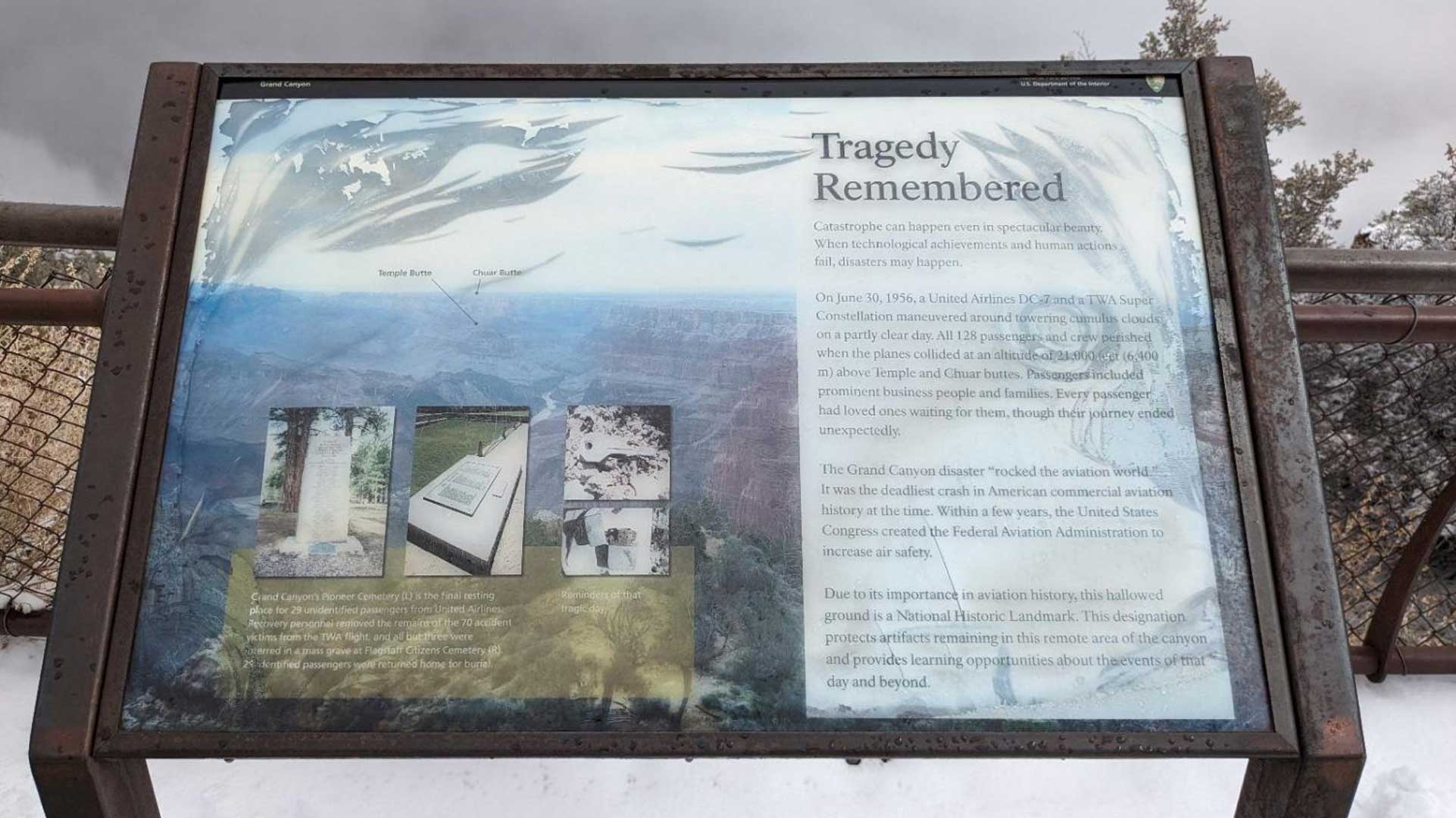 Wreckage from a 1956 midair collision sits on the floor of the Grand Canyon.
Wreckage from a 1956 midair collision sits on the floor of the Grand Canyon.
In the back of Flagstaff Citizen’s Cemetery hides a memorial for what was once the deadliest commercial airline disaster in U.S. history.
It’s unassuming and could easily be missed, but author Susan Johnson knows it’s there. She points out a pair of faded black-and-white photos placed on a plaque.
"It looks like both of those photos are of stewardesses," Johnson said. "Two young women who are — maybe the same young woman? I can’t quite tell… — who were a stewardess onboard."
The patch of grass is no bigger than a swimming pool. It’s lined with small obelisks connected by a chain with a plaque that lists the names of the 66 people buried there.
"But you really wouldn't know that even unless you walk up the steps and look down at the bronze and read the plaque, Johnson said. "And then you realize, "Oh, this is a mass burial place.'"
 VIEW LARGER The memorial in Citizens Cemetery in Flagstaff in 2024. The burial site contains the remains of 67 of the passengers and crew members aboard a TWA plane when it collided with a United flight over the Grand Canyon in 1956. All 128 people on both planes died.
VIEW LARGER The memorial in Citizens Cemetery in Flagstaff in 2024. The burial site contains the remains of 67 of the passengers and crew members aboard a TWA plane when it collided with a United flight over the Grand Canyon in 1956. All 128 people on both planes died. The grave commemorates the passengers and crew aboard a TWA Constellation when it collided with a United Airlines DC-7 over the Grand Canyon on June 30, 1956. One plummeted straight down while the other eventually collided with a cliff face. No one survived.
A thousand miles away, two-year-old Mike Nelson waited at the airport for his Uncle Jack.
"I was there," Nelson said. "I was riding on my grandpa's shoulders and my mom had my baby sister with her and we were waiting for my uncle. So, we were there when they first announced that the plane was lost and hadn't been heard from for hours . . . Nobody in my family had much real hope."
 A plaque at the Grand Canyon commemorates the crash of a TWA Constellation and a United Airlines DC-7 over the canyon on June 30, 1956.
A plaque at the Grand Canyon commemorates the crash of a TWA Constellation and a United Airlines DC-7 over the canyon on June 30, 1956.
The planes went down in a remote and rugged area of the canyon. Unpredictable air currents made for challenging helicopter flights to the site. Swiss mountain climbers were recruited to help recover victims’ remains and pieces of the wreckage for analysis.
Six days after the crash, Nelson’s family got the call that his uncle had been identified.
"You can't question it when they find a body that's got the wedding ring with the right inscription inside of it," he recounted. "It had to be Jack Groshans —my uncle. It said, 'Jack and Joyce forever inside it.'"
Not everyone could be identified, though. After an investigation, 66 of the 70 TWA passengers and crew were buried in Flagstaff. Another memorial at the Grand Canyon Pioneer Cemetery on the South Rim houses the 29 unidentified victims of the United flight.
"I personally believe this is probably the most important aircraft accident that we've had."
That’s Bill Waldock. He’s an aviation safety professor at Embry-Riddle Aeronautical University in Prescott specializing in aircraft crash investigations.
"Not because of the 128 people that died, not because of the loss of the two airplanes, but because of all the changes that came about as a direct result of the accident," Waldock added.
The crash prompted numerous new safety regulations, like the consolidation of air traffic control under a single government agency that became the Federal Aviation Administration.
"When you look at the changes that were made in the aftermath of the ‘56 midair [and the 1960 New York midair collision] — completely revamped our aerospace system," Waldock said. "We have not had another accident like that where two large airliners hit each other in U.S. airspace with U.S.-registered airplanes. Not a one."
The crash site was declared a National Historic Landmark in 2014, although the remote area of the Grand Canyon has been off-limits since the 1950s to deter attempts to retrieve the remaining wreckage.
Nelson, whose uncle died in the crash, is nearing 70 now. He’s yet to make the hike down to the site. He says he rarely thought about the collision until he was 40. Then, it consumed him.
"I needed to know more and more and more. At first, they thought I was just researching what happened to my uncle. But that's all it took, and it never went away. I never dithered in that."
His decades-long search for understanding ultimately turned into a book and later a group dedicated to preserving and teaching the history of the crash.
And, to honor victims, the City of Flagstaff recently allocated $40,000 to repair and improve the marker.


By submitting your comments, you hereby give AZPM the right to post your comments and potentially use them in any other form of media operated by this institution.